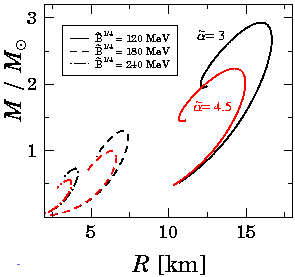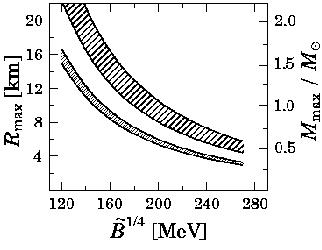|
There is the long standing conjecture that in the cores of neutron
stars the matter resides in a deconfined state (cf. [1] and
further references therein).
Basing on the speculation of self-bound strange quark matter
also pure strange quark stars have been predicted (cf. [2]
for a reference list for this topic).
The theoretical study of this subject was hampered up to now by the
poorly known equation of state at large baryon density.
However, recently a considerable progress has been made in calculating
the equation of state at vanishing baryon density [3].
In [4] we have
shown that the lattice QCD data can be described within a
quasiparticle
model. This model allows to map the lattice results to finite
baryon density. Provided the quasiparticle nature does not change,
the equation of state is accessible in such a way.
Surprisingly, the numerically obtained results at vanishing
temperature can be approximated by p = ae - 4 [B\tilde],
where p is the thermodynamical pressure, e the total energy
density, a = 3.0 ¼4.5 and [B\tilde]1/4 = 200 ¼260 MeV.
The ranges of a and [B\tilde] are a
direct consequence of the yet existing uncertainty of the lattice QCD
results.
Exploiting the given parameterization one can integrate the
TOV equations to get the masses and radii of cold, pure quark
stars in local b equilibrium, as displayed in Figs. 1 and 2.
Due to the b equilibrium a large fraction of the quarks
occurs as strange quarks.
Of course, the existence of pressure-free deconfined matter is
questionable, therefore, one should study hybrid stars by
interpolating from our high-density equation of state to
nuclear matter densities, where the equation of state is fairly well
known.

|

|
|
Fig. 1
The dependence of the mass of pure quark stars with strangeness
on the radius for several values of the parameters
a and [B\tilde]1/4.
|
Fig. 2
Maximum masses (upper hatched band,
right scale) and corresponding radii (lower hatched band, left scale)
of pure quark stars
as a function of [B\tilde]1/4.
The upper (lower) limit of the bands is for a = 3 (4.5).
|
1Dept. of Physics, Brookhaven Nat. Lab., Upton, NY 11973,
USA
2 Institut für Theoretische Physik, TU Dresden
References
[1]
B. Kämpfer, J. Phys. A 14 (1981) L471,
Phys. Lett. B 158 (1984) 121
[2]
K. Schertler, C. Greiner, J. Schaffner-Bielich, M.H. Thoma,
Nucl. Phys. A 677 (2000) 463
[3]
F. Karsch, E. Laermann, A. Peikert,
Phys. Lett. B 478 (2000) 447
[4]
A. Peshier, B. Kämpfer, G. Soff, Phys. Rev. C 61 (2000) 045203
IKH
05/31/01
© B. Kämpfer
|

